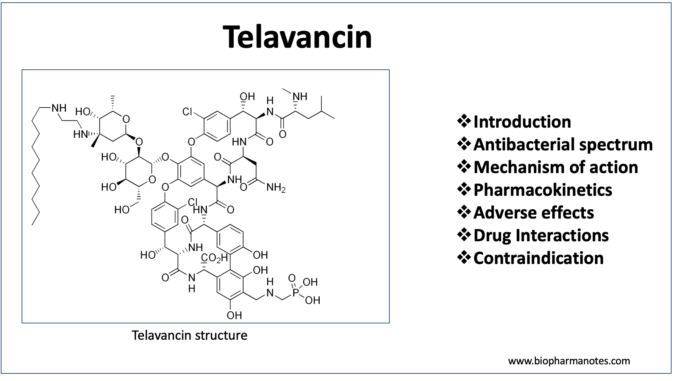
- Telavancin is semisynthetic lipoglycopeptide derivative of vancomycin with a hydrophobic side chain attached to vancosamine sugar.
- It was discovered in 2000 and is first marketed semisynthetic lipoglycopeptide. It was approved for its medical use by FDA in September 2009. Use includes treatment of serious gram- positive bacterial infections.
Antibacterial spectrum of Telavancin
- Telavancin exerts concentration dependent bactericidal activity. It is active against gram-positive bacteria including methicillin resistant S. aureus (MRSA), S. pyrogens, S. pneumonia. It is also effective against some isolates of vancomycin resistant enterococci (VRE).
- Not effective against gram negative bacterial infection.
Indications of telavancin
- Used in treating complicated skin and skin structure infection (cSSI) caused by gram-positive bacteria including methicillin susceptible or resistant S. aureus infection, vancomycin susceptible Enterococcus faecalis, Streptococcus agalactiae and Streptococcus anginosus group. It is used as an alternative to vancomycin, daptomycin and linezolid in treating cSSI caused by resistant gram-positive bacteria.
- Used in treating hospital acquired bacterial pneumoniae and ventilator associated bacterial pneumoniae in adult patients caused by methicillin susceptible or resistant S. aureus. It is the last agent of choice in these cases and is used when other alternative treatments are not effective.
Mechanism of action of telavancin
- It has dual mechanism of action. As it is derivative of vancomycin, its mechanism of action is quite like that of vancomycin. It acts by inhibiting bacterial cell wall synthesis. Peptidoglycans are major structural component of gram- positive bacterial cell wall. It binds to terminal dipeptide (D-ala- D-ala) sequence of peptidoglycan precursor unit i.e., NAM (N- acetyl muramic acid) and NAG (N- acetyl glucosamine). Then it prevents incorporation of NAM and NAG subunits into peptidoglycan matrix. Hence, it inhibits bacterial cell wall synthesis.
- It also disrupts bacterial cell membrane potential like daptomycin which results in intracellular inhibition of protein, RNA and DNA synthesis ultimately leading to cell death. This additional bactericidal mechanism is due to presence of lipophilic side chain and is reason behind additional antibacterial potency of telavancin when compared to vancomycin.
Pharmacokinetics
- It is administered via IV route and typical administration time is 60 minutes of IV infusion. More than 90% of administered drug binds to protein, mainly albumin.
- Metabolism doesn’t involve cytochrome P450 enzymes. Its primary metabolite is THRX- 651540. Its half-life is around 7-9 hours and this long half-life allows once per day dosing.
- It undergoes renal elimination. Around 80% of drug is excreted unchanged in urine. Dosage adjustment is required in renal patients.
Adverse effects
- It can cause side effects like taste disturbance, nausea, vomiting, nephrotoxicity, and QT prolongation which are the reasons for its limited use. It may also cause foamy urine and interfere in coagulation.
- Rapid infusion can cause ‘red man syndrome’ symptoms. It can interfere with laboratory coagulation test and can cause increase in value of INR (International Normalized Ratio), PTT (Partial Thromboplastin Time) and aPTT (activated partial thromboplastin time).
Drug Interaction
- It can interact with drugs that can prolong the QTc interval. Such drugs include azole antifungal agents, macrolides, and fluoroquinolones. Hence, it should be used with care when co-administering with these agents.
- It should be used with caution when co-administering with nephrotoxic agents.
Contraindications
- When used in pregnancy, it can cause farm to fetus. It has box warning which recommend doing pregnancy test before starting the telavancin therapy. It is used in pregnancy only if its potential benefits outweigh the risks.
- Contraindicated in patients with known hypersensitivity to telavancin or other known components of the formulation.
References
- https://go.drugbank.com/drugs/DB06402
- Damodaran SE et al. Telavancin: A novel lipoglycopeptide antibiotic. J Pharmacol Pharmacother. 2011 Apr-Jun; 2(2): 135–137.
- Saravolatz LD et al. Telavancin: A Novel Lipoglycopeptide. Clinical Infectious Diseases. 2009; 49(12): 1908–1914.
- Wenzler E et al. Telavancin: The Long and Winding Road from Discovery to Food and Drug Administration Approvals and Future Directions. Clinical Infectious Diseases. 2015; 61(2): S38–S47.
- Meyler’s Side Effects of Drugs. The International Encyclopedia of Adverse Drug reactions and Interactions. 16th edition.
- Lippincott Illustrated Reviews Pharmacology, 6th edition.
- Pharmacology and pharmacotherapeutics. 24th edition.